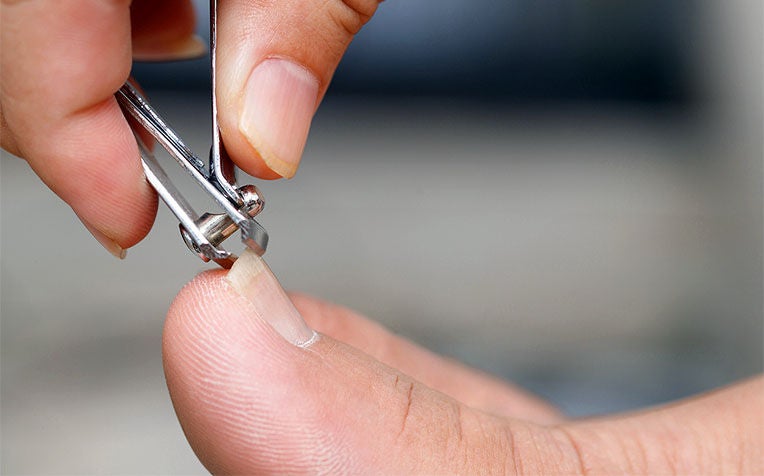
Toenails should be cut straight across and not in a curved manner, with the edges to be filed down. Also, use a nailclipper and avoid tearing your nails.
An ingrown toenail occurs when part of the nail punctures the surrounding skin, creating a wound.
“Ingrown toenails once set in, would rarely self-resolve,” shares Podiatrist Leonard Tan from SingHealth Polyclinics (SHP), a member of the SingHealth group. “Among the patients I see, around 15 to 20 per cent of them are presented with ingrown toenail problem,” he adds.
What to do when you have an ingrown toenail
Mild ingrown toenails can typically be managed conservatively by removing the offending nail spike and allowing the site to recover.
But refrain from using inappropriate equipment when removing the offending nail as this could complicate and worsen the ingrown nail, leaving nail spikes which could introduce infection. The use of off-the-counter ointments or medications to resolve ingrown toenails is also not encouraged.
With proper maintenance, there is a good chance that the ingrown toenail will not recur.
However, if the mild ingrown nail is not resolved, do seek timely advice from your local podiatrist or a medical professional for suitable treatment options.
How is an ingrown toenail treated?
A procedure used to remove the toenail partially (also known as a nail avulsion), followed by cauterisation of the wound, or other ways my be considered to prevent the nail from growing back.
For such procedures, the offending part of the nail is excised and a matrixectomy (removing or killing the nail matrix) is performed to prevent the ingrowing nail from growing back.
4 tips to prevent an ingrown toenail from occurring/recurring
Prevention is the best way to reduce the risk of developing ingrown toenails.
Ensuring that you use good nail cutting techniques and wearing good footwear are two simple yet important actions that you can take to reduce the likelihood of developing ingrown toenails.
1. Cut toenails straight across (not in a curved manner) and file the edges down

Above: The proper way to cut and file toenails.
Cutting your nails straight across, filing the edges down, and avoid digging into the sides of your nails, which can leave painful nail spikes at the side of the nail can help to prevent ingrown nails. Also, refrain from cutting your nails too short.
2. Don’t pluck or pick your nails
Avoid plucking or picking the nails as well as the skin around the nails as they provide a natural waterproofing seal from bacteria and germs.
3. Wear proper fitting shoe with sufficient toe space
Wearing proper fitting shoes with sufficient toe box space, can reduce the occurrence of ingrown toenails.
The
space between the longest toe to the end of the shoe should be one thumb spacing.
If possible, you should also avoid pointed shoes that squeeze the sides of your feet and toes.
4. Keep your nails clean and dry
Maintain good personal foot hygiene by keeping your nails clean and dry. Avoid soaking your feet in hot water for prolonged periods of time as this can reduce the integrity of the skin surrounding your toenails.
Also, routinely inspect your foot and nails for any changes (e.g. discolorations, swelling). If you do notice changes (e.g. nail lifting, yellow brown or black discolouration, nail splitting), it would be prudent to have it examined by a health professional to avoid the condition from worsening.
Why are teens and seniors more prone to ingrown toenails?
Although anyone can develop ingrown toenails at any points of their lives, teenagers and the elderly are at highest risk of developing ingrown toenails.
“One of the most common reasons for teenagers to develop ingrown toenails would be the wearing of poor-fitting footwear. Also, some teens may be active in high-impact sports, such as football which can induce trauma when kicking the ball, and the condition may worsen if they wear tight shoes. Some even have the bad habit of peeling their toenails at the sides, instead of trimming them, and the jagged nail may irritate the tissue, causing an ingrown toenail,” explains Podiatrist Leonard Tan.
“For the elderly with poor balance, they are at higher risk of getting ingrown toenail from trauma if their foot kicks against furniture, or possibly from wearing tight fitting shoes with narrow toe box. This may worsen in seniors with swollen foot or with fluid retention. Not wearing the correct length and width of footwear will cause ingrown toenails for them. In addition, they may not be able to trim the nails properly at the side due to poor eyesight or reduced mobility,” he adds.
Apart from ill-fitting footwear and impact to the toe, other factors that can lead to ingrown toenails include:
Genetically speaking, you are at a higher risk if you have a family history of developing ingrown toenails. For instance, you may intrinsically have a curved or wider nail plate or a tighter nail sulcus (the skin that surrounds the side of the nails) that predisposes you to ingrown toenails.
In some cases, side effects from medications such as certain acne or cancer drugs can lead to ingrown toenails.
Other possible causes of ingrown toenails include fungal or bacterial infections, and practicing incorrect nail trimming techniques
Symptoms of an ingrown toenail
The signs of an ingrown toenail normally mirror that of an infection. These include:
Pain in the side of the toe
Swelling
Warmth and redness
Pus
Fever and chills
Ingrown toenails are often painful and can disrupt even simple day to day activities, such as putting on your shoes.
In addition, if the site of the ingrown toenail gets infected, it can cause discomfort when there is contact with the infected part of your toe during your activities. If the infection has progressed, you may even have a fever or feel unwell.
Complications can arise from an ingrown toenail
Occasionally, prolonged ingrown toenails may lead to improper wound healing, with red tissue growth surrounding the offending area that bleeds easily.
In more serious cases, sepsis may set in, leading to amputation, which should not be taken lightly. This is especially so for those with a compromised immune system, such as diabetes patients (diabetics).
When to see a podiatrist
“It’s easier and less painful to treat an ingrown nail sooner rather than later. Therefore, once you notice pain in the side of the toe together with other symptoms such as swelling, warmth, redness, pus, bleeding, fever, chills or discomfort, that would be an appropriate time to seek medication attention,” advises Podiatrist Leonard Tan.
Ref: I23
More articles on foot care you may be interested in:
Ankle Arthritis (Ankle Pain): How to Manage
Achilles Tendon Pain: Causes and How to Treat
Flat Foot/Flat Feet: What to Do
Contributed by


















 Get it on Google Play
Get it on Google Play